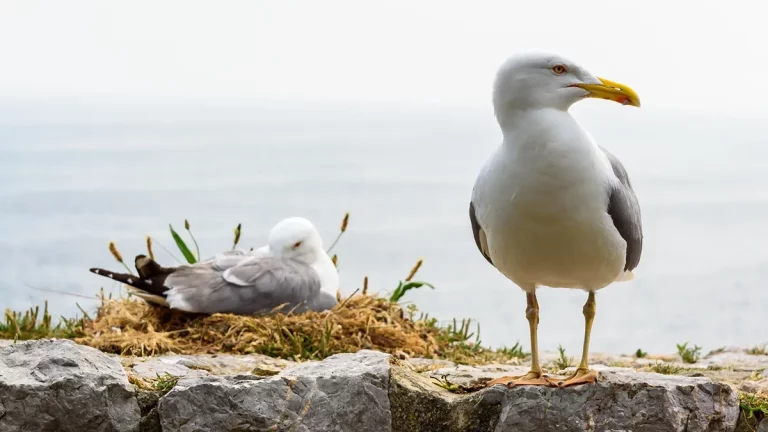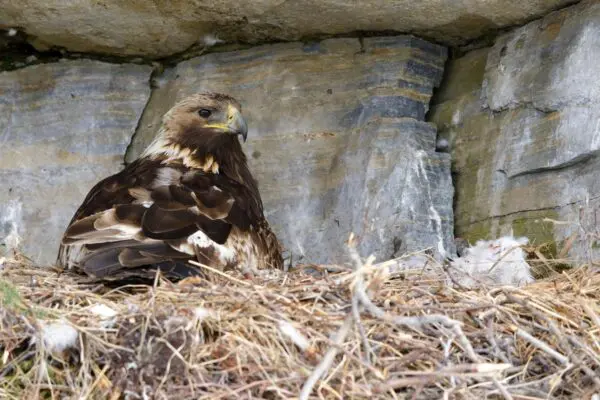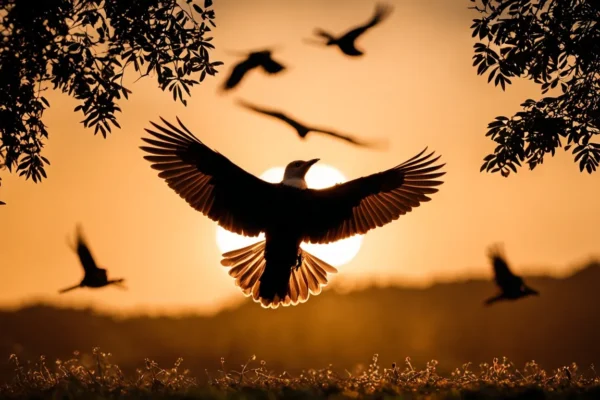Seagulls are a common sight along the shore and in many interior rivers, whether they are scavenging fries or hunting for fish and crustaceans. Although they may not be liked by everyone, gulls serve an essential role as scavengers and predators.
When there are enough food supplies and secure nesting locations close to towns and cities, several of the more than 50 species of gulls have grown quite prevalent. Despite their abundance, not many people would have seen their nests or noticed their fascinating breeding habits.
We will cover every aspect of seagull nesting in this article. Follow along to discover everything from the locations of their nests to the methods used to tend to the young.
Important Information on Seagull Nesting
Nesting season:
March to July (starts in late April in Europe)
Nesting materials
Grass and twigs
Sort of nest
Cup-shaped Nesting sitetrees, houses, cliffs, and dunes
Size of clutch: 2–4 eggs
30-day incubation period
45-day fledgling period
Selecting the Ideal Location
When selecting a nest site, gulls prioritize safety, as seen by their preference for remote locations such as cliffs and islands. While Bonaparte’s Gull (Chroicocephalus philadelphia) has the unusual habit of nesting on trees, the majority of species are ground-nesters.
Due to a lack of suitable places, many species may nest in colonies, which are sometimes quite near to one another and occasionally mixed with other bird species. Naturally, gulls also prioritize the availability of food for their developing offspring, which is why they often nest in metropolitan or coastal regions with thriving fisheries, as well as close to landfills and other foraging locations.
Gulls have adapted to constructing and bridging manmade structures in many places of the earth. These provide a high level of shelter from scavenging predators and resemble their native cliff habitats in form.
The Laughing Gull (Larus atricilla) is one of the species that may spend many weeks at a suitable nest site before starting nest building, demonstrating the importance of site selection. Following the acquisition of a favorable location, gull couples often return to nest in the same region or even on the same land in subsequent years.
Season of the Year
In the northern hemisphere, gulls normally lay their eggs between March and September throughout the spring and summer. But according on their species and environment, their time differs.
Because they do not have to wait for the snow to melt before laying their eggs, nesters in the South may start sooner.
For instance, gulls in Alaska start laying eggs in mid-May, whereas in the Gulf of California, they might start as early as mid-March.
Nest Building
Both sexes gather materials and carry them on their bills while they construct the nest. To protect it from the prevailing winds, they typically construct their nest up against a rock or bush.
Many gull species only make a small scrape in the sand or dirt and line it with some plant material, stones, seashells, and feathers; they are not very skilled nest builders. These birds will also use a variety of man-made objects, such as plastic and rope fragments.
But not every gull builds its nest on the ground. The kittiwake (Rissa tridactyla) nests on a little pile of plants and mud on the narrow ledges of cliffs. Meanwhile, in shallow freshwater marshes, the inland North American species known as Franklin’s Gull (Leucophaeus pipixcan) constructs a floating plant nest.
Typically spherical, gull nests may take on a variety of shapes, from traditional saucer or cup forms to towering mounds. The Little Gull (Hydrocoloeus minutus) has a diameter of a little over 7 inches, whereas the biggest species has a diameter of more than 1½ feet. Old nests may be reused by pairs, and when fresh material is added, they can become rather big.
Mating and Breeding
Some gulls may mate for life, while others establish monogamous couples. Early spring is the time of romance when partners bond or reconnect upon reaching the breeding grounds.
Before the female deposits her eggs, they will court one another and accomplish the delicate balancing process of mating many times in a week or two. Various calls and activities that deepen bonds, such as feeding each other, are all part of courtship.
Eggs
A solitary clutch of expertly disguised, speckled eggs that merge seamlessly with their nest is laid by gulls. Usually ranging in size from 1.5 inches (40mm) and 20g in tiny species like the Little Gull to 3 inches (77mm) and 117 g in the Great Black-backed Gull (Larus marinus), they produce one to five (usually two to three) rather big eggs. In the United States, a medium chicken egg weighs 1.75 oz (50 g).
The Young Gull’s Life Cycle:
Depending on the species, the period from hatching to independence might be many months.
After three to five weeks of incubation by both parents, the majority of gull eggs hatch. On their first day of life, the semi-precocial young can see and walk, and they often leave the nest shortly after hatching. They spend the first two to three weeks close to the nest, however, and don’t go too far. Like its hatching shell, gull chicks are secretly disguised in black and gray-brown speckles.
Before becoming independent, gull chicks must eat regularly for many weeks while being brooded during their first few days. It can take many years for juvenile birds to attain sexual maturity and grow their adult feathers. Bigger species, such as the Great Black-backed Gull, may begin to reproduce as early as age four or five, which is comparable to the average lifespan of many smaller bird species.
Parental Guidance
Male and female gulls cooperate to hunt and feed their young, and they are monogamous. Depending on their species, the chicks usually fledge after six weeks of being nourished via regurgitation. Certain species’ chicks may stay close to their parents even after they have fled, begging for food for as long as six months until they learn how to fend for themselves.
Although they take great care when selecting a nest location, parents almost never leave their young chicks alone. Gulls, on the other hand, are not scared to protect their nests, and the colony may take coordinated action to ward off an intruder.
Because gulls are scavengers and opportunistic predators by nature, gull flocks together represent a serious threat. These birds established well-defended areas that varied in diameter from a few feet to a few yards in order to reduce their losses. Pairs vigorously protect their territory with cries, displays, and, if needed, actual combat.
Obstacles and Dangers
For all bird species—including gulls—the period leading up to nesting is perilous. Because these birds nest in very exposed regions, they are always at risk from predation and harsh weather. Gull eggs and chicks will be a feast for several mammalian predators, such as foxes, minks, and weasels.
Although numerous birds also eat the eggs and chicks of gulls, nesting in inaccessible locations might lessen the danger of these ground predators. Among the possible predators are Great-horned Owls, Crows, Ravens, and various gulls.
Although many gull species are declining as a result of many reasons including pollution, overfishing, and climate change, gulls are often adaptive and opportunistic birds. Six species are classified as vulnerable and four as near-threatened on the IUCN Red List.
Fascinating Information and Observations About Seagull Nesting
There is a red patch on the beak of many gulls. A crucial visual signal that stimulates chicks to begging from their parents is this “target.”
Even when they are far from their own nest, gulls will congregate in great numbers in the air above possible predators at the colony.
Gulls often consume the eggs and young of other gulls as well as other species. In the colony, some gulls even eat the young of other gull species.
Final Thoughts
In their densely populated colonies, gulls exhibit intricate territorial communication and floating nests, among other amazing nesting and breeding habits.
Whether on a rooftop in the heart of the city or in a secluded and untamed coastal seabird colony, witnessing Gull nesting behavior may be an amazing experience. Just keep in mind that these birds will not back down from defending their nests!
Although it is unfortunate that many people consider seagulls to be bothersome creatures, maybe we can continue to adapt and learn how to coexist with nature on our ever-changing planet.
FAQs
How long does it take for seagulls to hatch?
The typical hatching period for seagull eggs is three to five weeks, depending on the species. To transmit body heat, both parents grow brood patches, and they alternate incubating the eggs.
What percentage of juvenile seagulls survive?
Remarkably long lives are had by gulls; many reach the age of twenty, and some go close to fifty! Adults, especially in cities, have a relatively high survival rate and very few predators. But becoming an adult is dangerous, and only approximately half of juvenile Herring Gulls make it to the point of fledging.
How can one watch seagulls build their nests without upsetting them?
A birdwatcher’s best buddy is binoculars. Any adult gull that is nesting may become anxious when approached, and they may even react violently in unexpected ways! It’s preferable to observe from a distance while keeping a check on the parent birds. If they begin to become agitated, you’re getting a little too near.
What actions can we take to support gull conservation efforts?
One of the finest ways to support gull conservation is to volunteer or donate to charities and conservation groups. But we can also make a difference by making simple decisions like recycling, avoiding things that come in needless plastic packaging, and staying away from seafood that isn’t sustainable.





![Are Red Peacocks Real? [Unlocking the Mystery]](https://birdsology.com/wp-content/uploads/2023/06/46-600x400.jpg.webp)
